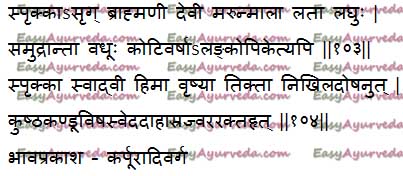Sprikka – Anisomeles malabarica: Benefits, Qualities, Indications
By Dr Renita D’Souza
Sprikka (Anisomeles malabarica) is an aromatic Ayurvedic herb used in many Ayurvedic pain relieving and vata balancing formulations. It detoxifies blood and used skin diseases, itching, burning sensation, fever, poisoning etc. It is also called Sprukka.
Botanical Name – Anisomeles malabarica Family – Lamiaceae
Table of Contents
Vernacular names, Sanskrit verse
Vernacular Names
Hindi Name – Gopoli, Codhara
Kannada Name – Karithumbe, Hetthumbe
Gujarathi Name – Makhamali Chodaro
Telugu Name – Mogabiraku
Malyalam Name – Perumtumpa, Karithumba,
Konkani Name – Katumbo
English Name – Malabar catmint

Qualities, uses
Medicinal Qualities of Anisomeles malabarica
Rasa (taste) – Tiktha (bitter)
Virya (potency) – Sheetha (cold)
Karma (action) – Vrushya (aphrodisiac)
Uses
During indigestion, abdominal colic it is taken internally and externally its paste is applied over stomach.
Essential oil is used as pain reliever. In joint pain essential oil is applied followed by sudation with its leaves.
Indications of Sprukka:
Kushta – skin diseases
Kandu – itching
Visha – toxic conditions, poisoning
Sweda – excess sweating
Daha – burning sensation
Jwara – fever Blood disorders
Ashree – depression, bad luck etc
Sprikka – Effect on doshas Balances all three doshas
Interaction with medicines, supplements
Can this be used while taking Homeopathic medicine?
Yes. Sprukka does not react with homeopathic medicine.
Can
this medicine be continued while taking supplements like multivitamin tablets,
Omega 3 fatty acids etc?
Yes. Generally, this product goes well with most
of the dietary supplements. However, if you are taking more than one product
per day, please consult your doctor for an opinion.
With western
medicines
Seek your
doctor’s advice if you are taking this product along with other western
(allopathic / modern) medicines. Some Ayurvedic herbs can interact with modern
medicine.
If both Ayurvedic and allopathic medicines are advised together, then it is
best to take Allopathic medicine first, wait for 30 minutes and then take the
Ayurvedic medicine.
Dose, morphology, distribution
Dosage Swarasa (juice) – 3 – 5 ml Oil – 2 – 5 drops
Part Used Whole plant
Morphology of Anisomeles malabarica
It is a herb which grows up to 4 – 6 ft in height. Leaves are aromatic and oblong – lanceolate in shape. They have light purple flowers.
Distribution of Codhara
Found in India, Bangladesh, Sri Lanka, Andaman and Nicobar Islands, Thailand, Malaysia, Indonesia, New Guinea, Bismarck Archipelago, Mauritius, Northern Australia.
Pharmacology, research
Pharmacological Activities of Gopoli:
Anticancer, Analgesic, anti helmintic, anti-allergic, anti anaphylactic, anti bacterial, anti carcinogenic, anti ecdemic, anti histaminic, anti-inflammatory, anti leukemic, anti plasmodial, antiseptic and antibiotic properties
Research Points
1. Anti bacterial activity
2. Analgesic – Study done to investigate the analgesic activity of leaf extract of Anisomeles malabarica have concluded significant analgesic activity of Anisomeles malabarica plant.
3. Anti pyretic activity – Research done to investigate anti inflammatory and anti pyretic activity of Anisomeles malabarica leaves extract have concluded the significant anti inflammatory and anti pyretic activity of crude leaf extracts of Anisomeles malabaric.
4. Anticancer activity – A research study done to evaluate anticancer activity of Anisomeles malabarica (L.)R.Br. ethanolic leaf extract on DEN (Diethylnitrosamine) induced Albino mice have concluded significant anticancer activity of ethanolic extract of Anisomeles malabarica
Side effects There are no recorded side effects.
Chemistry, medicines, category
Chemical Constituents
Sprukka contains alkaloids, tannins, flavonoids, phytosterol and coumarin. It yields essential oil.
Ayurvedic Medicines with Sprikka Ingredient
Sahacharadi Thailam – It is widely used Ayurvedic oil both externally and as internal medication in conditions such as Vata diseases, tremors, convulsions, psychosis, stiffness of thigh, muscle cramps, muscle wasting, muscle weakness, gynaecological disorders etc
Nisosiradi Thailam – Used for external application in diabetic carbuncles, abscesses, sinuses, boils etc
Arimedadi Thailam – It is used for gargling to strengthen teeth and sense organs. It helps to relieve tooth decay, removes stains, bad breath, useful in pericoronitis, gum abscess, Burning mouth syndrome etc
aladhatryadi Thailam – Used in headache, eye disorders, burning sensation in eyes, gout arthritis, emaciation, it strengthens muscle, improves quality of blood.
Bala Tel – Used in vata diseases, vomiting, cough, cold, fever, asthma, wound, emaciation, epilepsy etc
Eladi Thailam – Used in skin diseases like allergic dermatitis, ring worm infection, urticaria, scabies, acne scars, defective teeth, diseases of gums and mouth, ear ache and boils etc
Classical Categorisation Bhavaprakasha – Karpuradi Varga
Sanskrit Synonyms Sprikka, Sprukka, Asrk Brahmani, Devi Marunmala Latha, Laghu Laghu, Samudrantha Vadhu, Kotivarsha Lankopika
Click to Consult Dr Renita D’Souza










